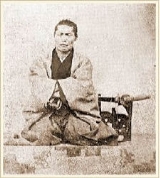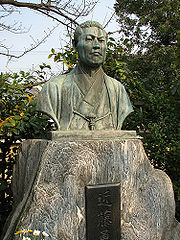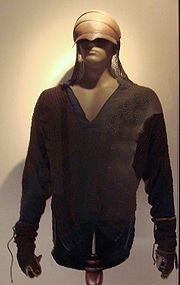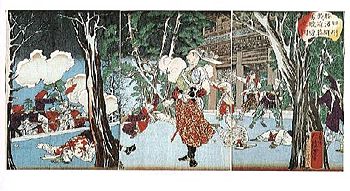
Kondo Isami
Encyclopedia
was a Japanese swordsman and official
of the late Edo Period
, famed for his role as commander of the Shinsengumi
.
 Isami, who was first known as Katsugorō, was born to Miyagawa Hisajirō, a farmer residing in Kami-Ishihara village in Musashi Province
Isami, who was first known as Katsugorō, was born to Miyagawa Hisajirō, a farmer residing in Kami-Ishihara village in Musashi Province
, now in the city of Chōfu
in Western Tokyo
. He had two older brothers, Otojirō (音次郎; later known as Otogorō 音五郎) and Kumezō (粂蔵; later known as Sōbei 惣兵衛). Katsugorō began training at the Shieikan (the main dojo of the Tennen Rishin-ryū
) in 1848.
As a young man he was said to be an avid reader, and especially liked the stories of the Forty-seven Ronin
and the Romance of the Three Kingdoms
. His renown as a scholar and his fame at having defeated a group of thieves who tried to break into his family home was great, and caught the attention of Kondō Shūsuke, the third generation master of the Tennen Rishin-ryū. Shūsuke wasted no time in adopting the young Katsugorō in 1849, who first took the name of Shimazaki Katsuta (島崎勝太). According to a record in the possession of the former Gozu-tennōsha Shrine 牛頭天王社 (now the Hino Yasaka-jinja Shrine 日野八坂神社), Katsuta is listed, with full common name and formal name, as Shimazaki Isami Fujiwara (no) Yoshitake (島崎勇藤原義武), and thus, had the name Isami (勇) as of 1858, the document's date.
Kondō is said to have owned a katana
called "Kotetsu" (虎徹), the work of the 17th century swordsmith Nagasone Kotetsu
. However, the authenticity
of his "Kotetsu" is highly debatable. According to Yasu Kizu's pamphlet on the swordmaker Kotetsu, Kondō's sword may actually have been made by Minamoto no Kiyomaro, a swordmaker of high repute roughly contemporary to Kondō.
Kondō and his wife, Otsune, were married in 1860. This was an advantageous match for Kondō; Otsune was the daughter of Matsui Yasogorō (松井八十五郎), a retainer to the Shimizu-Tokugawa
clan. On September 30, 1861, Isami became the fourth generation master (sōke no yondai me 宗家四代目) of Tennen Rishin-ryū, assuming the name Kondō Isami and taking charge of the Shieikan. A year later, his daughter Tamako (1862–1886) was born. Kondō's only grandson, Kondō Hisatarō, was killed in action
in the Russo-Japanese War
.
 Although he was never employed by the Shogunate before his Shinsengumi days, Kondō was a candidate for a teaching position at the Kobusho in 1862. The Kobusho was an exclusive military training school, primarily for the use of the shogunal retainers, set up by the Shogunate in 1855 in order to reform the military system after the arrival of Perry's Black Ships
Although he was never employed by the Shogunate before his Shinsengumi days, Kondō was a candidate for a teaching position at the Kobusho in 1862. The Kobusho was an exclusive military training school, primarily for the use of the shogunal retainers, set up by the Shogunate in 1855 in order to reform the military system after the arrival of Perry's Black Ships
.
organized a massive group of ronin
for the purpose of protecting the shogun Iemochi
during his time in Kyoto. Kondō joined the unit, which became known as the Rōshigumi
, with his close friend Hijikata Toshizō
, as well as Shieikan's members and guests Yamanami Keisuke
, Okita Sōji
, Harada Sanosuke
, Nagakura Shinpachi
, Tōdō Heisuke
, and Inoue Genzaburō
. After the de facto commander Kiyokawa Hachirō revealed their true purpose as being Imperial supporters, Kondō, Hijikata, former Mito retainer Serizawa Kamo
, and a handful of others remained in Kyoto
and formed the Mibu Rōshigumi. Acting under the direct orders of the shogunate, Matsudaira Katamori
of Aizu
undertook supervision of these men. Under the oversight of Aizu, acting in its role as Protector of Kyoto
, they worked as police in the imperial capital.
In the August 18 incident Kinmon no Seihen, his unit was given the name Shinsengumi. In June (lunar calendar
) 1864, the Shinsengumi became well known for arresting a cell of shishi
(the incident was known as the Ikedaya Jiken
, or Ikedaya Affair).
On July 10, 1867, Kondō became a hatamoto
, along with the rest of Shinsengumi.

 After the Battle of Toba-Fushimi
After the Battle of Toba-Fushimi
in January 1868, he returned to Edo
, and was promoted to the rank of wakadoshiyori
(wakadoshiyori-kaku 若年寄格) in the rapidly disintegrating Tokugawa administration. He fought with the force dispatched by the Imperial Court but lost, most notably at the battles of Kōshū-Katsunuma
and Nagareyama
. After surrendering, he was beheaded at Itabashi on May 17 (lunar calendar
April 25) 1868.
According to Tani Tateki
(1837–1911) of the Tosa han
, Kondō was executed by the new government (formed mostly by the samurai of the Chōshū han and the Satsuma han) as a direct result of being accused of the murder of Sakamoto Ryōma
. Even after ex-Mimawarigumi member Imai Nobuo's confession in 1870, Tani insisted that Kondō was not falsely accused for Sakamoto's murder. (Even though the most accepted theory is that the mastermind of assassination
was Sasaki Tadasaburō of the Mimawarigumi, officially, it is still a mystery.)
He has several grave sites; it is believed that the first of them was the grave erected at Ten'nei-ji Temple (天寧寺) in Aizu
by Hijikata Toshizō
. Hijikata, who was convalescing nearby from a foot injury sustained at the Battle of Utsunomiya, is said to have personally supervised the preparation and construction of the site. Kondō's funerary name, Kanten'inden'junchūseigi-daikōji (貫天院殿純忠誠義大居士) is believed to have been granted by Matsudaira Katamori
.
Official
An official is someone who holds an office in an organization or government and participates in the exercise of authority .A government official or functionary is an official who is involved in public...
of the late Edo Period
Edo period
The , or , is a division of Japanese history which was ruled by the shoguns of the Tokugawa family, running from 1603 to 1868. The political entity of this period was the Tokugawa shogunate....
, famed for his role as commander of the Shinsengumi
Shinsengumi
The were a special police force of the late shogunate period.-Historical background:After Japan opened up to the West following U.S. Commodore Matthew Perry's visits in 1853, its political situation gradually became more and more chaotic...
.
Background

Musashi Province
was a province of Japan, which today comprises Tokyo Prefecture, most of Saitama Prefecture and part of Kanagawa Prefecture. It was sometimes called . The province encompassed Kawasaki and Yokohama...
, now in the city of Chōfu
Chofu, Tokyo
is a city located in the western end of Tokyo Metropolis, Japan. As of 2010, the city has an estimated population of 224,878 and a population density of 10,440 persons per km². The total area was 21.53 km². Tokyo Stadium in Chōfu hosts soccer games for two J. League teams: F.C...
in Western Tokyo
Western Tokyo
Western Tokyo, also known as the , or , consists of the part of Tokyo Prefecture to the west of the 23 special wards.-Overview:Whereas the special wards occupy the space that was formerly the city of Tokyo, western Tokyo consists of the 26 cities, three towns, and one village that were not part of...
. He had two older brothers, Otojirō (音次郎; later known as Otogorō 音五郎) and Kumezō (粂蔵; later known as Sōbei 惣兵衛). Katsugorō began training at the Shieikan (the main dojo of the Tennen Rishin-ryū
Tennen Rishin-ryu
is a Japanese martial art, commonly known as the style practiced by several core members of the Shinsengumi.-History:Founded by Kondō Kuranosuke Nagahiro around 1789, the style was popularized by Kondō Shūsuke , the third generation master of the style, who, together with Satō Hikogorō, spread its...
) in 1848.
As a young man he was said to be an avid reader, and especially liked the stories of the Forty-seven Ronin
Forty-seven Ronin
The revenge of the , also known as the Forty-seven Samurai, the Akō vendetta, or the took place in Japan at the start of the 18th century...
and the Romance of the Three Kingdoms
Romance of the Three Kingdoms
Romance of the Three Kingdoms, written by Luo Guanzhong in the 14th century, is a Chinese historical novel based on the events in the turbulent years near the end of the Han Dynasty and the Three Kingdoms era of Chinese history, starting in 169 and ending with the reunification of the land in...
. His renown as a scholar and his fame at having defeated a group of thieves who tried to break into his family home was great, and caught the attention of Kondō Shūsuke, the third generation master of the Tennen Rishin-ryū. Shūsuke wasted no time in adopting the young Katsugorō in 1849, who first took the name of Shimazaki Katsuta (島崎勝太). According to a record in the possession of the former Gozu-tennōsha Shrine 牛頭天王社 (now the Hino Yasaka-jinja Shrine 日野八坂神社), Katsuta is listed, with full common name and formal name, as Shimazaki Isami Fujiwara (no) Yoshitake (島崎勇藤原義武), and thus, had the name Isami (勇) as of 1858, the document's date.
Kondō is said to have owned a katana
Katana
A Japanese sword, or , is one of the traditional bladed weapons of Japan. There are several types of Japanese swords, according to size, field of application and method of manufacture.-Description:...
called "Kotetsu" (虎徹), the work of the 17th century swordsmith Nagasone Kotetsu
Nagasone Kotetsu
' was a Japanese swordmaker of the early Edo period. Kotetsu was born in Sawayama around 1597, and was first known as Nagasone Okisato. His father was an armorer who served Ishida Mitsunari, the lord of Sawayama...
. However, the authenticity
Authentication
Authentication is the act of confirming the truth of an attribute of a datum or entity...
of his "Kotetsu" is highly debatable. According to Yasu Kizu's pamphlet on the swordmaker Kotetsu, Kondō's sword may actually have been made by Minamoto no Kiyomaro, a swordmaker of high repute roughly contemporary to Kondō.
Kondō and his wife, Otsune, were married in 1860. This was an advantageous match for Kondō; Otsune was the daughter of Matsui Yasogorō (松井八十五郎), a retainer to the Shimizu-Tokugawa
Gosankyo
The ' were three branches of the Tokugawa clan of Japan. They were descended from the eighth of the fifteen Tokugawa shoguns, Yoshimune . Yoshimune established the Gosankyo to augment the Gosanke, the heads of the powerful han of Owari, Kishū, and Mito...
clan. On September 30, 1861, Isami became the fourth generation master (sōke no yondai me 宗家四代目) of Tennen Rishin-ryū, assuming the name Kondō Isami and taking charge of the Shieikan. A year later, his daughter Tamako (1862–1886) was born. Kondō's only grandson, Kondō Hisatarō, was killed in action
Killed in action
Killed in action is a casualty classification generally used by militaries to describe the deaths of their own forces at the hands of hostile forces. The United States Department of Defense, for example, says that those declared KIA need not have fired their weapons but have been killed due to...
in the Russo-Japanese War
Russo-Japanese War
The Russo-Japanese War was "the first great war of the 20th century." It grew out of rival imperial ambitions of the Russian Empire and Japanese Empire over Manchuria and Korea...
.

Black Ships
The Black Ships was the name given to Western vessels arriving in Japan in the 16th and 19th centuries.In 1543 Portuguese initiated the first contacts, establishing a trade route linking Goa to Nagasaki...
.
Shinsengumi Period
In 1863, the Tokugawa shogunateTokugawa shogunate
The Tokugawa shogunate, also known as the and the , was a feudal regime of Japan established by Tokugawa Ieyasu and ruled by the shoguns of the Tokugawa family. This period is known as the Edo period and gets its name from the capital city, Edo, which is now called Tokyo, after the name was...
organized a massive group of ronin
Ronin
A or rounin was a Bushi with no lord or master during the feudal period of Japan. A samurai became masterless from the death or fall of his master, or after the loss of his master's favor or privilege....
for the purpose of protecting the shogun Iemochi
Tokugawa Iemochi
was the 14th shogun of the Tokugawa shogunate of Japan, who held office 1858 to 1866. During his reign there was much internal turmoil as a result of Japan's first major contact with the United States, which occurred under Commodore Perry in 1853 and 1854, and of the subsequent "re-opening" of...
during his time in Kyoto. Kondō joined the unit, which became known as the Rōshigumi
Roshigumi
The Rōshigumi , the "Kyoto Defenders", was a group of 234 masterless samurai , founded by Kiyokawa Hachirō in 1863. Loyal to the Bakufu, they were supposed to act as the protectors of the Tokugawa shogun....
, with his close friend Hijikata Toshizō
Hijikata Toshizo
was the vice-commander of Shinsengumi, a great swordsman and a talented Japanese military leader who resisted the Meiji Restoration.-Background:...
, as well as Shieikan's members and guests Yamanami Keisuke
Yamanami Keisuke
was a Japanese samurai. He was the General Secretary of the Shinsengumi, a special police force in Kyoto during the late Edo period.-Background:...
, Okita Sōji
Okita Soji
, was the captain of the first unit of the Shinsengumi, a special police force in Kyoto during the late shogunate period. He was one of the best swordsmen of the Shinsengumi, along with Saito Hajime and Nagakura Shinpachi....
, Harada Sanosuke
Harada Sanosuke
was a Japanese warrior who lived in the late Edo period. He was the 10th unit captain of the Shinsengumi, and died during the Boshin War.-Background:...
, Nagakura Shinpachi
Nagakura Shinpachi
was the captain of the 2nd troop of the Shinsengumi.-Background:Nagakura Shinpachi Noriyuki, known as Eikichi or Eiji during his childhood, was born in the Matsumae clan's "kami-yashiki" in Edo on the 11th day of the fourth month of Tenpō 10 His father, Nagakura Kanji, was a retainer of the...
, Tōdō Heisuke
Todo Heisuke
Tōdō Heisuke Tōdō Heisuke Tōdō Heisuke (藤堂 平助 1844 – December 13, 1867)was a samurai of Japan's late Edo period who served as the eighth unit captain of the Shinsengumi. His full name was Tōdō Heisuke Fujiwara no Yoshitora.-Background:...
, and Inoue Genzaburō
Inoue Genzaburo
was born in Bushu . He was the captain of the sixth unit of the Shinsengumi which were a special police force for the Tokugawa regime....
. After the de facto commander Kiyokawa Hachirō revealed their true purpose as being Imperial supporters, Kondō, Hijikata, former Mito retainer Serizawa Kamo
Serizawa Kamo
Serizawa Kamo was a samurai known for being the original lead commander of the Shinsengumi. He trained in and received a licence in the Shindō Munen-ryū. "Kamo" means goose or duck in Japanese which was an odd name to call oneself at the time...
, and a handful of others remained in Kyoto
Kyoto
is a city in the central part of the island of Honshū, Japan. It has a population close to 1.5 million. Formerly the imperial capital of Japan, it is now the capital of Kyoto Prefecture, as well as a major part of the Osaka-Kobe-Kyoto metropolitan area.-History:...
and formed the Mibu Rōshigumi. Acting under the direct orders of the shogunate, Matsudaira Katamori
Matsudaira Katamori
was a samurai who lived in the last days of the Edo period and the early to mid Meiji period. He was the 9th daimyo of the Aizu han and the Military Commissioner of Kyoto during the Bakumatsu period. During the Boshin War, Katamori and the Aizu han fought against the Meiji Government armies, but...
of Aizu
Aizu
is an area comprising the westernmost third of Fukushima Prefecture in Japan. The principal city of the area is Aizuwakamatsu.During the Edo period, Aizu was a feudal domain known as and part of Mutsu Province.-History:...
undertook supervision of these men. Under the oversight of Aizu, acting in its role as Protector of Kyoto
Kyoto Shugoshoku
The ' was a Japanese bureaucratic office of the Tokugawa shogunate from 1862 through 1868. The officeholder was responsible for keeping the peace in the city of Kyoto and its environs, and in this role, largely supplanted the extant office of Kyoto Shoshidai, though the two offices existed side by...
, they worked as police in the imperial capital.
In the August 18 incident Kinmon no Seihen, his unit was given the name Shinsengumi. In June (lunar calendar
Lunar calendar
A lunar calendar is a calendar that is based on cycles of the lunar phase. A common purely lunar calendar is the Islamic calendar or Hijri calendar. A feature of the Islamic calendar is that a year is always 12 months, so the months are not linked with the seasons and drift each solar year by 11 to...
) 1864, the Shinsengumi became well known for arresting a cell of shishi
Shishi (organization)
Shishi was a term used to describe Japanese political activists of the late Edo period...
(the incident was known as the Ikedaya Jiken
Ikedaya Jiken
The , also known as the Ikedaya Affair or Ikedaya Incident, was an armed encounter between the shishi which included masterless samurai formally employed by the Chōshū and Tosa clans , and the Shinsengumi, the Bakufu's special police force in Kyoto on July 8, 1864 at the Ikedaya Inn in Kyoto,...
, or Ikedaya Affair).
On July 10, 1867, Kondō became a hatamoto
Hatamoto
A was a samurai in the direct service of the Tokugawa shogunate of feudal Japan. While all three of the shogunates in Japanese history had official retainers, in the two preceding ones, they were referred to as gokenin. However, in the Edo period, hatamoto were the upper vassals of the Tokugawa...
, along with the rest of Shinsengumi.
Boshin War and Death


Battle of Toba-Fushimi
The occurred between pro-Imperial and Tokugawa shogunate forces during the Boshin War in Japan. The battle started on 27 January 1868 , when the forces of the Tokugawa shogunate and the allied forces of Chōshū, Satsuma and Tosa domains clashed near Fushimi...
in January 1868, he returned to Edo
Edo
, also romanized as Yedo or Yeddo, is the former name of the Japanese capital Tokyo, and was the seat of power for the Tokugawa shogunate which ruled Japan from 1603 to 1868...
, and was promoted to the rank of wakadoshiyori
Wakadoshiyori
The ', or "Junior Elders", were high government officials in 17th century Tokugawa Japan. The position was established around 1631, but appointments were irregular until 1662....
(wakadoshiyori-kaku 若年寄格) in the rapidly disintegrating Tokugawa administration. He fought with the force dispatched by the Imperial Court but lost, most notably at the battles of Kōshū-Katsunuma
Battle of Koshu-Katsunuma
The was a battle between pro-Imperial and Tokugawa shogunate forces during the Boshin War in Japan. The battle followed the Battle of Toba-Fushimi on 29 March 1868 .-Prelude:...
and Nagareyama
Nagareyama, Chiba
is a city located in northern Chiba Prefecture, Japan. As of February 2011, the town had an estimated population of 164,683 and a population density of 4670 persons per km²...
. After surrendering, he was beheaded at Itabashi on May 17 (lunar calendar
Lunar calendar
A lunar calendar is a calendar that is based on cycles of the lunar phase. A common purely lunar calendar is the Islamic calendar or Hijri calendar. A feature of the Islamic calendar is that a year is always 12 months, so the months are not linked with the seasons and drift each solar year by 11 to...
April 25) 1868.
According to Tani Tateki
Tani Tateki
-External links:...
(1837–1911) of the Tosa han
Tosa Domain
The was a feudal domain in Tosa Province of Japan during the Edo period. Its official name is . Some from the domain played important roles in events in the late Tokugawa shogunate...
, Kondō was executed by the new government (formed mostly by the samurai of the Chōshū han and the Satsuma han) as a direct result of being accused of the murder of Sakamoto Ryōma
Sakamoto Ryoma
was a leader of the movement to overthrow the Tokugawa shogunate during the Bakumatsu period in Japan. Ryōma used the alias .- Early life :Ryōma was born in Kōchi, of Tosa han . By the Japanese calendar, this was the sixth year of Tenpō...
. Even after ex-Mimawarigumi member Imai Nobuo's confession in 1870, Tani insisted that Kondō was not falsely accused for Sakamoto's murder. (Even though the most accepted theory is that the mastermind of assassination
Assassination
To carry out an assassination is "to murder by a sudden and/or secret attack, often for political reasons." Alternatively, assassination may be defined as "the act of deliberately killing someone, especially a public figure, usually for hire or for political reasons."An assassination may be...
was Sasaki Tadasaburō of the Mimawarigumi, officially, it is still a mystery.)
He has several grave sites; it is believed that the first of them was the grave erected at Ten'nei-ji Temple (天寧寺) in Aizu
Aizu
is an area comprising the westernmost third of Fukushima Prefecture in Japan. The principal city of the area is Aizuwakamatsu.During the Edo period, Aizu was a feudal domain known as and part of Mutsu Province.-History:...
by Hijikata Toshizō
Hijikata Toshizo
was the vice-commander of Shinsengumi, a great swordsman and a talented Japanese military leader who resisted the Meiji Restoration.-Background:...
. Hijikata, who was convalescing nearby from a foot injury sustained at the Battle of Utsunomiya, is said to have personally supervised the preparation and construction of the site. Kondō's funerary name, Kanten'inden'junchūseigi-daikōji (貫天院殿純忠誠義大居士) is believed to have been granted by Matsudaira Katamori
Matsudaira Katamori
was a samurai who lived in the last days of the Edo period and the early to mid Meiji period. He was the 9th daimyo of the Aizu han and the Military Commissioner of Kyoto during the Bakumatsu period. During the Boshin War, Katamori and the Aizu han fought against the Meiji Government armies, but...
.

